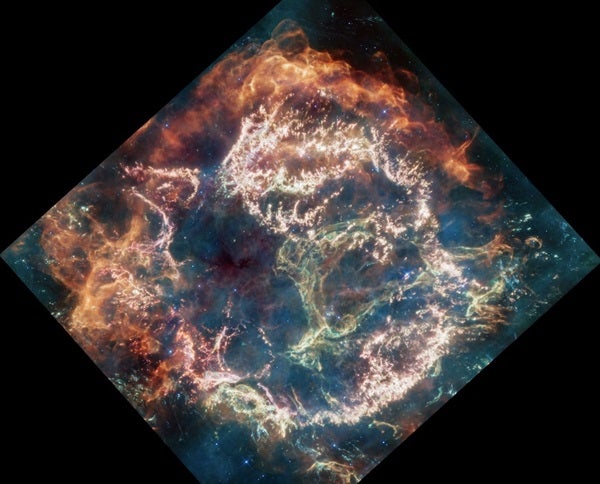
Some 350 years ago, the dodo bird went extinct, Sir Isaac Newton invented calculus, and Cassiopeia A (Cas A) burst into existence. Cassiopeia A is supernova remnant that originally formed when a star some five times the mass of the Sun catastrophically exploded, spewing its innards outward.
And recently, NASA’s James Webb Space Telescope (JWST) captured detailed images of this well-known supernova remnant to help astronomers better understand the composition of the doomed star that gave birth to it.
“Cas A represents our best opportunity to look at the debris field of an exploded star and run a kind of stellar autopsy to understand what type of star was there beforehand and how that star exploded,” said Danny Milisavljevic of Purdue University, principal investigator of the Webb program, in a NASA release.
Investigating the remains of a stellar explosion
Cassiopeia A spans some 10 light-years across and resides roughly 11,000 light-years from Earth.
In the image above, taken by JWST’s Mid-Infrared Instrument (MIRI), Cas A is seen encased in a layer of reddish-orange warm dust to the top and left. This marks where material ejected from the star during the supernova event is colliding with surrounding gas and dust.
The glowing pink strands are remnants of the former star itself, made up of heavy elements such as oxygen, argon, and neon — as well as other sources researchers are still working to identify.
Near the center of the remnant, you also may notice a wide-mawed green shape. “We’ve nicknamed it the Green Monster in honor of Fenway Park in Boston. If you look closely, you’ll notice that it’s pockmarked with what look like mini-bubbles,” said Milisavljevic. “The shape and complexity are unexpected and challenging to understand.”
JWST’s detailed views of the Cassiopeia A supernova remnant provide researchers with insight into one of the cosmos’ most important dust-creation mechanisms. And cosmic dust is vital to understand because it plays a pivotal role in the creation of planets, as well as ourselves.
“By understanding the process of exploding stars, we’re reading our own origin story,” said Milisavljevic. “I’m going to spend the rest of my career trying to understand what’s in this data set.”









